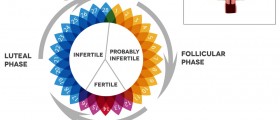
Changes in the cervical mucus happen during the menstrual cycle and the quantity and quality are very important to determining overall fertility. In human reproduction fertile mucus has the important function of supporting conception, providing sperm with an environment in which to survive and propel towards the egg. Cervical mucus protects sperm from the hostile acid environment of the vagina, insulates and nourishes sperm and extends their life span. The way cervical or luteal phase mucus will change as a woman moves through her menstrual cycle and the quantity, are key signs of when a female is the most fertile. The look and appearance of cervical mucus will also change during the cycle and may become white, creamy textured, yellow and translucent or transparent.
During the first phase of menstruation, mucus may be light or dry and thick, the color will probably be white. As the second phase of the menstrual cycle begins, estrogen production increases and moisture, volume and texture will change considerably. Transitional cervical mucus may be sticky and hold shape when stretched. When luteal phase mucus is present it will be abundant and characterized by a transparent appearance, resembling raw egg whites. Fertile cervical mucus is also stretchy, which is called Spinnbarkeit and it is indicative of ovulation being very close. Following ovulation, cervical mucus will again change because of estrogen decreasing and progesterone increasing. Changing cervical mucus is something that happens each month and when trying to conceive a woman should pay attention and note when she is most fertile and likely to become pregnant.
















Your thoughts on this
Loading...